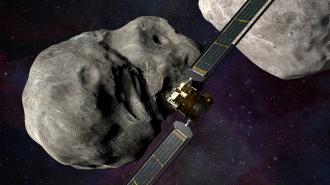NASA’s Double Asteroid Redirection Test (DART) has gotten its first look at the Didymos asteroid system — and in just a few days, it will attempt to smash into one of the space rocks in the hope of helping NASA prevent a future asteroid impact with Earth.
The challenge: Our solar system contains millions of rocky objects left over after the formation of the planets and moons. The biggest of these are asteroids, and while most never get close to us, if a large one were to hit Earth’s surface, the impact could be devastating.
NASA keeps an eye out for potentially hazardous asteroids, and if it saw one heading our way, we might be able to prevent the collision by slamming something into the threatening space rock to redirect it — but no one has attempted an asteroid-redirection mission before, so we don’t know for sure how or if it would work.
“This first set of images is being used as a test to prove our imaging techniques.”
Elena Adams
The DART spacecraft: Since we wouldn’t want to wait until our planet is at risk to find out whether it is possible to redirect an asteroid, NASA launched DART, the world’s first planetary defense experiment, in November 2021.
The DART spacecraft is expected to make impact with Dimorphos, a small asteroid orbiting the larger Didymos asteroid, on September 26, 2022, when the pair are about 7 million miles from Earth — nowhere near close enough to harm our planet.
NASA will then use data from the collision to inform future asteroid redirection experiments and, if needed, actual planetary defense missions.
Eyes on the prize: During its 10-month journey to the Didymos asteroid system, the DART spacecraft has used an imager, DRACO (Didymos Reconnaissance and Asteroid Camera for Optical navigation), to snap thousands of photos.
By combining nearly 250 images captured by DRACO on July 27, 2022, NASA has produced DART’s first image of Didymos and Dimorphos.

Why it matters: DART’s ability to capture and process images of its target using DRACO is essential to the success of the mission — in the final four hours before impact, the DART spacecraft will need to navigate to the asteroids without human intervention, and those images will be vital to ensuring it hits its target.
“This first set of images is being used as a test to prove our imaging techniques,” said Elena Adams, the DART mission systems engineer at the Johns Hopkins Applied Physics Laboratory.
“The quality of the image is similar to what we could obtain from ground-based telescopes,” she continued, “but it is important to show that DRACO is working properly and can see its target to make any adjustments needed before we begin using the images to guide the spacecraft into the asteroid autonomously.”
We’d love to hear from you! If you have a comment about this article or if you have a tip for a future Freethink story, please email us at [email protected].




